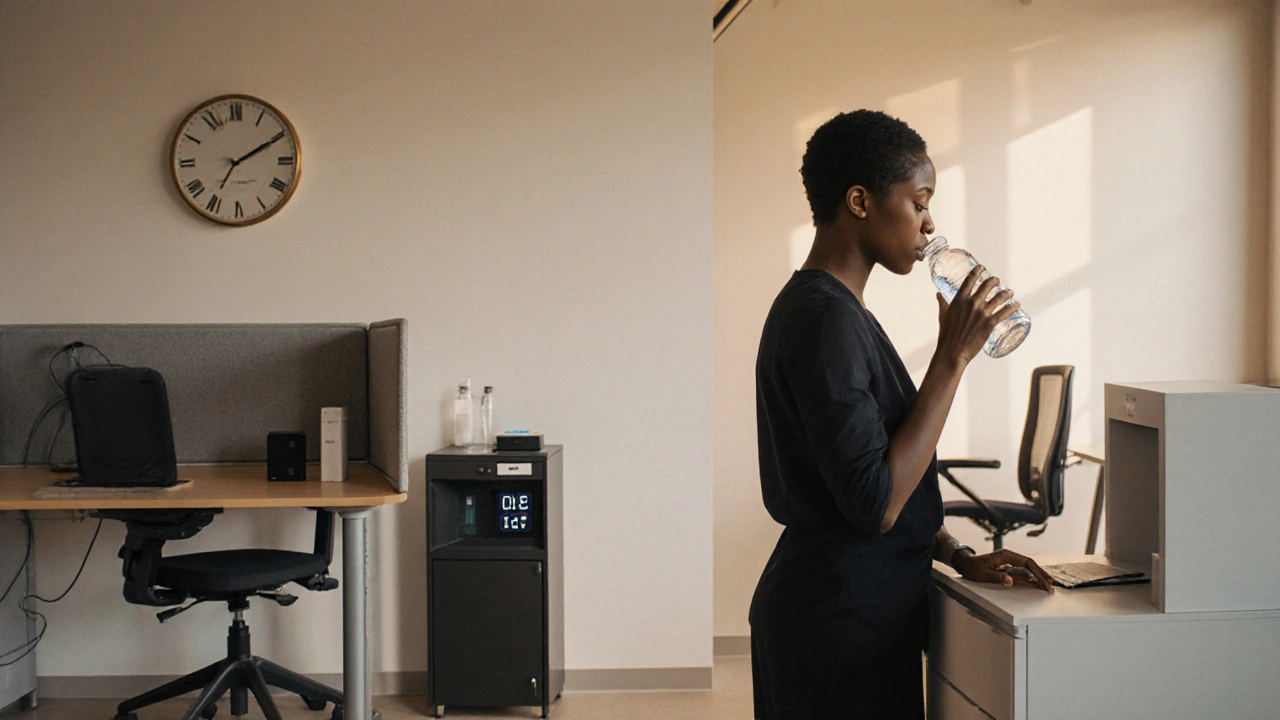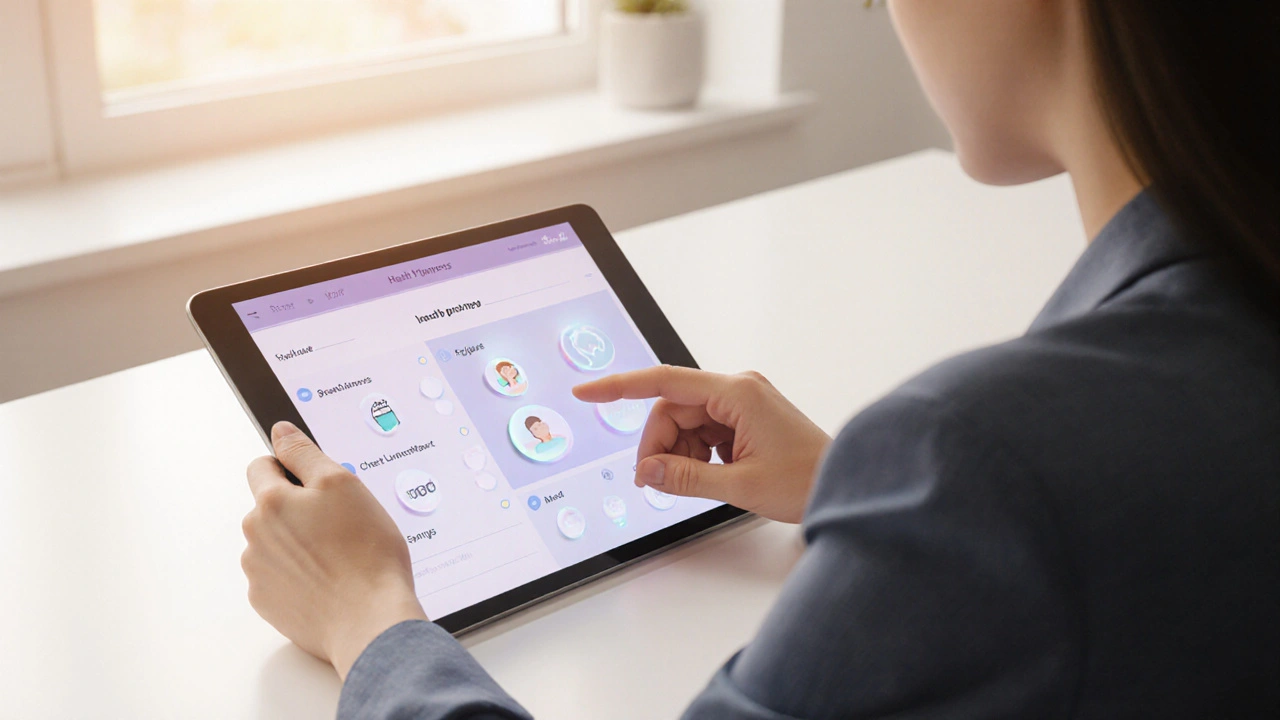PAH Symptom & Accommodation Planner
Common PAH Symptoms
Identify which symptoms most impact your daily work performance.
Workplace Adjustments
Select accommodations that could help manage your symptoms.
Your Personalized Plan
Selected Symptoms:
Requested Accommodations:
Emergency Planning Tips
- Keep a portable power source for medical devices
- Store medications safely in a lockable container
- Have a one-page emergency action plan with your name, diagnosis, and contact info
- Inform your travel provider about medical devices
Workplace Accommodation Reference Table
| Adjustment | Benefit for PAH | Implementation Ease |
|---|---|---|
| Flexible start/end times | Allows pacing around medication peaks and fatigue periods | High - simple schedule tweak |
| Ergonomic workstation (standing desk, chair with lumbar support) | Reduces strain on the heart and improves circulation | Medium - may require budget approval |
| Private area for prostacyclin pump or inhalation therapy | Ensures safe device handling and reduces infection risk | Medium - needs designated space |
| Additional short breaks (5-minute micro-breaks every hour) | Helps manage shortness of breath and prevent fatigue buildup | High - no extra cost |
| Remote-work options (full-day or hybrid) | Eliminates commuting stress and provides a controlled environment | Variable - depends on role |
Quick Takeaways
- Know your legal rights under Australian disability legislation.
- Identify the PAH symptoms that most affect your job.
- Prepare a clear, concise request for reasonable accommodation.
- Set up medication reminders and an emergency plan at work.
- Use lifestyle tricks-hydration, pacing, and stress control-to keep energy steady.
Living with Pulmonary Arterial Hypertension is a chronic challenge, but it doesn’t have to mean the end of a rewarding career. This guide walks you through the medical basics, the legal landscape in Australia, and practical steps to make the workplace a supportive space.
What Is Pulmonary Arterial Hypertension?
PAH is a rare, progressive disease where the arteries that carry blood from the heart to the lungs become narrowed or blocked. The result is higher pressure in the pulmonary arteries, forcing the right side of the heart to work harder. Typical values: mean pulmonary artery pressure ≥25mmHg at rest. In Australia, about 1 in 10,000 adults are diagnosed each year, according to the Australian Pulmonary Hypertension Association.
Key treatment classes include:
- Endothelin receptor antagonists (e.g., bosentan, ambrisentan)
- Phosphodiesterase‑5 inhibitors (e.g., sildenafil, tadalafil)
- Prostacyclin analogues (e.g., epoprostenol, treprostinil) - often delivered via continuous infusion.
These medications improve blood flow but can cause side‑effects like headache, flushing, or fatigue, which directly impact work performance.
How PAH Shows Up at Work
Most people with PAH report a mix of physical and mental hurdles that can affect daily tasks:
- Fatigue - a lingering low‑energy state that worsens after prolonged sitting or standing.
- Shortness of breath during brisk walks or climbing stairs, which may limit commuting options.
- Chest discomfort or palpitations that can be alarming in high‑stress environments.
- Mood swings and anxiety, especially when medication schedules are disrupted.
Understanding which of these symptoms hit you hardest is the first step toward tailoring workplace solutions.
Australian Legal Rights and Protections
In Australia, the Disability Discrimination Act 1992 (DDA) protects employees with disabilities-including chronic illnesses like PAH-from discrimination. Employers with 15 or more staff must make reasonable accommodations unless it would cause unjustifiable hardship.
Key points to remember:
- Disability is defined broadly, covering conditions that substantially limit one or more major life activities, such as breathing or stamina.
- You are not required to disclose your diagnosis, but sharing enough information helps the employer assess suitable adjustments.
- Requests must be made in writing, outlining the specific limitation and the proposed accommodation.
- If an employer refuses, you can lodge a complaint with the Australian Human Rights Commission.

Talking to Your Employer: A Step‑by‑Step Playbook
Preparing for that conversation can feel daunting, but a structured approach keeps things focused.
- Gather Documentation - a letter from your cardiologist confirming the diagnosis, current functional limitations, and suggested workplace tweaks.
- Identify Core Needs - list the top three adjustments that would make the biggest difference (e.g., flexible start times, a private space for infusion pumps).
- Draft a Request Email - keep it concise: state your condition, explain how it impacts your role, and propose specific accommodations.
- Offer a Meeting - suggest a short face‑to‑face or virtual chat to discuss details and answer questions.
- Follow Up - if you don’t hear back within a week, send a polite reminder or ask HR for an update.
Sample opening line: “I would like to discuss a few workplace adjustments that could help me manage my Pulmonary Arterial Hypertension while maintaining productivity.”
Practical Adjustments You Can Request
Below is a quick reference of common accommodations and how they help manage PAH symptoms.
| Adjustment | Benefit for PAH | Implementation Ease |
|---|---|---|
| Flexible start/end times | Allows pacing around medication peaks and fatigue periods | High - simple schedule tweak |
| Ergonomic workstation (standing desk, chair with lumbar support) | Reduces strain on the heart and improves circulation | Medium - may require budget approval |
| Private area for prostacyclin pump or inhalation therapy | Ensures safe device handling and reduces infection risk | Medium - needs designated space |
| Additional short breaks (5‑minute micro‑breaks every hour) | Helps manage shortness of breath and prevent fatigue buildup | High - no extra cost |
| Remote‑work options (full‑day or hybrid) | Eliminates commuting stress and provides a controlled environment | Variable - depends on role |
When you present the table, link each request to a specific symptom you’ve identified. This shows the employer that the adjustments are not “nice‑to‑have” but essential for safe performance.
Medication Management and Emergency Planning at Work
Keeping your therapy on track while at the office requires a few logistical steps:
- Set Digital Reminders - use phone alarms, Outlook alerts, or a smartwatch to cue dosing times.
- Store Medications Safely - a lockable drawer in a shared office or a personal lockbox in a private room.
- Document Side‑Effects - maintain a brief log of any new symptoms; share trends with your treating physician.
- Prepare an Emergency Action Plan - a one‑page card with your name, diagnosis, emergency contacts, and key steps (e.g., “If chest pain worsens, call 000 and inform the nearest colleague”).
Many workplaces have an occupational health professional (OHP) who can store your plan and train coworkers on basic response measures.
Lifestyle Strategies to Keep Energy Up Through the Day
Beyond workplace tweaks, daily habits make a huge difference:
- Hydration - aim for 2-3L of water; dehydration can worsen blood pressure spikes.
- Timed Nutrition - small, balanced meals every 3‑4hours keep glucose stable and avoid post‑lunch fatigue.
- Gentle Movement - 5‑minute walks or seated leg lifts every hour improve circulation without overexertion.
- Stress‑Reduction Tools - breathing exercises, portable meditation apps, or a short power‑nap (if allowed) reset the nervous system.
When you notice a dip in stamina, use the “pacing rule”: tackle high‑focus tasks during your medication’s peak efficacy window (often 1-2hours after a dose) and reserve lighter admin work for low‑energy periods.
When to Seek Further Occupational Health Support
If you encounter any of the following, it’s time to loop in an OHP or your HR team:
- Sudden increase in breathlessness that interferes with basic tasks.
- Device malfunction (e.g., prostacyclin pump alarm) during work hours.
- Repeated missed doses due to schedule conflicts.
- Signs of mental health strain-persistent anxiety, low mood, or isolation.
An OHP can conduct a workplace risk assessment, recommend ergonomic upgrades, and liaise with your treating cardiologist to fine‑tune medication timing.

Frequently Asked Questions
Can I legally ask for a flexible schedule because of PAH?
Yes. Under the Disability Discrimination Act, a flexible schedule is a reasonable accommodation if it doesn’t cause undue hardship for the employer.
Do I have to disclose my exact diagnosis to my boss?
No. You only need to share enough medical information for the employer to understand the functional limitation and assess accommodations.
What if my employer says they can’t afford the requested adjustments?
Ask for a written explanation of the specific hardship. You can then propose alternative, lower‑cost solutions or request a review through the Australian Human Rights Commission.
How should I handle an infusion pump while traveling for work?
Carry a portable power source, keep the pump in a secure carry‑on, and have a printed emergency plan. Inform the airline and your hotel in advance about the medical device.
Is it okay to take short naps during the workday?
If your workplace culture permits it, a 10‑15 minute rest can boost alertness. You can frame it as a “micro‑break” for health and productivity.





October 3, 2025 AT 21:53 PM
Flexible start times can make a huge difference when medication peaks shift your energy. It lets you schedule meetings during the high‑energy window and take a quick recharge before the afternoon slump.
October 6, 2025 AT 05:26 AM
Agreed.
October 8, 2025 AT 13:00 PM
I’ve seen several colleagues benefit from pairing a brief morning walk with their medication schedule. The walk boosts circulation and can ease the shortness of breath that sometimes follows a dose. Pair that with a standing desk and you’ve got a compound effect on stamina. Keep a simple log of what works for you, and share it with your occupational health professional.
October 10, 2025 AT 20:33 PM
Remote‑work options have been a game changer for my PAH management. They eliminate the daily commute, which is when my breathlessness typically spikes.
October 13, 2025 AT 04:06 AM
One might ponder how the rhythm of breath aligns with corporate time structures. The modern office often imposes a clock that ignores physiological cycles. By requesting a flexible schedule, you are not merely asking for a perk but for alignment with your body’s natural cadence. This alignment can reduce stress hormones that exacerbate pulmonary pressure. In practice, propose a pilot period and present data on productivity gains.
October 15, 2025 AT 11:40 AM
I wish to commend the thorough presentation of the DDA framework. It provides a solid legal footing for any employee seeking reasonable adjustments.
October 17, 2025 AT 19:13 PM
The formal tone is appreciated, but here’s a practical tip: ask HR for a concise checklist of required medical documentation. Keeping it short helps both you and the employer move faster.
October 20, 2025 AT 02:46 AM
Honestly, most of these suggestions sound like common sense, but the real issue is getting management to actually listen.
October 22, 2025 AT 10:20 AM
When you first receive a PAH diagnosis, the workplace can feel like a labyrinth of obstacles and unanswered questions.
First, acknowledge that your body now operates on a different energy calendar than it did before.
Map out the times of day when your medication delivers its strongest boost and align your most mentally demanding tasks to that window.
Conversely, schedule routine emails, data entry, or low‑stakes meetings for the periods when fatigue tends to settle in.
Communicating this schedule to your manager shows you are proactive rather than merely requesting accommodations.
A concise email that outlines your peak productivity hours, your need for micro‑breaks, and any equipment requirements often opens the door to a collaborative solution.
Remember that Australian law protects you, so you can reference the Disability Discrimination Act without fear of retaliation.
If your employer balks, ask politely for a written explanation of any perceived hardship and be ready to suggest a lower‑cost alternative, such as a shared ergonomic chair.
Keeping a simple log of how you feel before and after each break can provide tangible data to support your requests.
Many companies have an occupational health officer who can serve as a neutral party to translate medical language into workplace policy.
Never underestimate the power of a well‑placed portable power bank for your infusion pump during especially long days.
A discreet lockable drawer or a small personal safe can keep your medication secure and give you peace of mind.
Hydration and small, frequent meals are small habits that compound into larger energy stability throughout the shift.
If you ever feel a sudden increase in shortness of breath, have a pre‑written one‑page emergency action plan ready to hand to a coworker.
With these strategies in place, PAH becomes a manageable factor rather than an insurmountable barrier to a rewarding career.
October 24, 2025 AT 17:53 PM
Thanks for the thorough rundown; I’ll try the hydration tip first.
October 27, 2025 AT 01:26 AM
Micro‑breaks every hour can be a simple win for everyone, not just those with PAH.
October 29, 2025 AT 09:00 AM
Imagine a workplace where the clock bows to the body’s rhythm, where each pause is a breath of relief, and where the boss sees the value in a well‑timed stretch. That vision isn’t far‑fetched; it’s built on data, empathy, and a dash of courage. When you propose a flexible schedule, frame it as a performance‑enhancing strategy, not a handicap. Offer to pilot the plan for a month and track output-numbers speak louder than complaints. In the end, the company gains a healthier, more focused employee, and you gain the space to thrive.
October 31, 2025 AT 16:33 PM
From a cultural perspective, it’s important to recognize that many workplaces still cling to the 9‑5 myth, which can marginalize those with chronic illnesses. By sharing stories like yours, we gradually shift the narrative toward inclusivity. In my region, we’ve started a peer‑support group that meets monthly to exchange accommodation ideas. It’s amazing how a simple spreadsheet of “what works” can become a powerful advocacy tool. Keep documenting your wins, and the broader community will benefit.
November 3, 2025 AT 00:06 AM
Love the cultural angle! 😊 It really resonates.
November 5, 2025 AT 07:40 AM
While the recommendations are solid, let’s not ignore the systemic inertia that often discounts ‘soft’ accommodations in favor of hard metrics. ROI‑centric models can sideline necessary health adjustments unless they’re quantified.